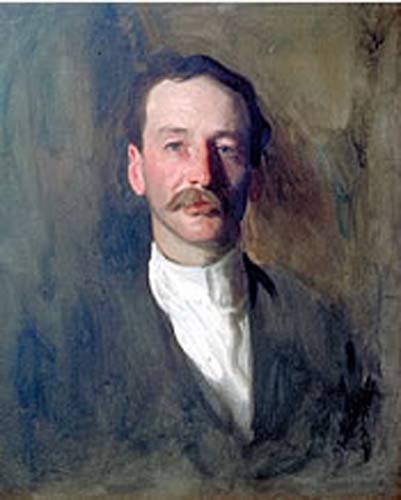Dr Morton
Prince
John Singer Sargent
-- American
painter
1890 or 1895?
Tufts University
Gallery
Medford, MA
Oil on Canvas
68.58 x 55.88 cm (27
x 22 in)
Gift of the Hanks
Estate
Jpg: Tufts
University Gallery
From: Richard Sugden,
PhD
(Wikipedia, submission)
Date: Mon, 8 Aug 2005
Morton
Henry Prince (December 21, 1854 – August 31, 1929). American
neurologist.
Morton Prince was an American
physican who specialized in neurology and abnormal psychology, and was
leading force in establishing psychology as a clinical and academic
discipline. He was part of a handful of men who disseminated European
ideas about psychopathology, especially in understanding dissociative
phenomenon. He was one of the founders of the Journal of Abnormal
Psychology in 1906, which he edited until his death in 1929. He also
established the Harvard Psychological Clinic in 1927.
Morton Prince came from a
wealthy Boston family and was involved in the social and intellectual
life of that city. He went to private schools and then to Harvard
College. He obtained his medical degree from Harvard Medical School in
1879. After Harvard, he took a "Grand Tour" of Europe, a near
requirement for upper-class Americans at that time. It was in Paris
that he visited Jean Martin Charcot at the Salpêtrière. He
was quite impressed with Charcot's theories but returned to Boston to
set up an otolaryngology practice. However, the spell of the
charismatic Charcot was strong and he quickly switch his practice to
neurology, and even adopted Charcot’s showmanship for teaching his
classes.
He became a devotee and avid
proponent in the use of suggestion in treating mental illnesses in the
United States and drew around him all the important practitioners in
the burgeoning field of abnormal psychology of that time: Boris Sidis,
James Jackson Putman, William James, G. Stanley Hall, to name but a
few. He became the American expert in dissociative disorders, which he
also called multiple personality disorder. (Many of his patients today
would probably be diagnosed as borderline personality disorder). He
published numerous accounts of cases, both in the academic press and
the popular press. His most famous case was that of Sally Beauchamp,
detailed in The Dissociation of a Personality (1906), which caused some
consternation, due both to the sensational nature of the cases
presented and to the convoluted prose style.
Prince maintained an active
professional life, not only with his psychopathologic studies but as
practicing physician as well. He was a prolific writer, publishing some
14 books and numerous essays. He wrote mostly on dissociation and
abnormal psychology but also applyed his understanding of the
unconscious to the politics of his day. Though his psychologcial ideas
never took hold, he remained an eminent figure, founding the Harvard
Psychological Clinic in 1927, only two years before his death. That
clinic established a major American strong hold for wide-ranging
psychological researches into personality that included a number of the
luminaries of that field (Henry Murray, Gordon Allport, and Robert W.
White), who all became famous extending the ideas that Prince first
taught them.
Prince was like many
prominent men of psychological science at the turn of the 20th century
who have become obscure. They were captivated by the new science of
mental life that attempted to wrestle psychopathology from the clutches
of moralism that deemed it a degeneracy or from medicine that saw a
heredity degeneracy, but had not yet developed an overarching theory.
Prince stressed the importance of the subconscious to hysterical
symptoms at the same time as Freud, but he was critical of
psychoanalysis and prefered to outline his idiosyncratic position that
never became popular. And his groundbreaking work on personality became
famous via Henry Murray, who took over as director of the Clinic and
worked on elaborating it into a more systematic and approachable manner.
(Wikipedia)
Note:
Special thanks to Wendy
& Gordon
Hawksley, of Sheffield England, friends
of the JSS Gallery, for sending a link to this image. And thanks to
Richard Sugden for letting me know about the article he was writing for
Wikipedia.
Sources
Hale, Jr., N. G. (1971).
Freud and
the Americans: The beginnings of psychoanalysis in the United States,
1876-1917. New York: Oxford University Press. ISBN 0195014278
Murray, H. A. (1956). Morton
Prince: sketch of his life and work. Journal of Abnormal and Social
Psychology, 52, 291-295.
Oltmanns, T. F. and Mineka,
S.
(1992). Morton Prince on anxiety disorders: Intellectual antecedents of
the cognitive approach to panic? Journal of Abnormal Psychology, 101,
607-610.
White, R. W. (1992 ). Who was
Morton Prince? Journal of Abnormal Psychology, 101, 604-606.
Selected
Publications
Prince, M. (1906). The
dissociation of a personality. New York: Longmans, Green, & Co.
Prince, M. (1909). My life as
a dissociated personality, by B.C.A. Prince, M (Ed.). Boston: R. G.
Badger.
Prince, M. (1915) The
psychology of the Kaiser: a study of his sentiments and his obsessions.
London: Unwin Ltd.
Prince, M. (1929). Clinical
and experimental studies in personality. Cambridge, MA: Sci-Art.
Prince, M. (1975).
Psychotherapy
and multiple personality: selected essays. Hale, Jr., N. G. (Ed.).
Cambridge, MA: Harvard University Press. ISBN 0674722256
|

